From landscapes to portraits, or for that matter almost any photographic genre, a tripod is a great asset.
There’s a fantastic selection to choose from, and while the range of features and appearance may differ, at the heart of all is a fundamental design; three legs that provide a firm, stable base for your camera.
Although many of us are familiar with camera terminology, when it comes to the humble tripod we can often be lost for words.
There are the obvious bits like the head, but what’s the name for the thing that connects the head to the legs? And then there are the less visible parts. Like the fiddly plastic bit that’s wrapped around the leg section and falls out when you dismantle a twist grip to clean it.
Some parts are obvious, others less so.
In this feature, I aim to reveal the true names for all those tripod parts so you too can become a tripod geek.
Knowing the correct name for something will naturally gain you respect from the photographic community, but armed with your new found knowledge it can also save you money.
No longer will something wear out without you knowing the name for the part. Equipped with the knowledge you can order that part for a few pounds rather than forking out a few hundred for an all-new tripod.
Let’s get started and take a look at the anatomy of the tripod from head to foot.
The Top Bit
An easy place to start is at the top, known as the head. Our tripod is the 3 Legged Thing Punks Billy which features a head with an Arca Swiss style release plate.
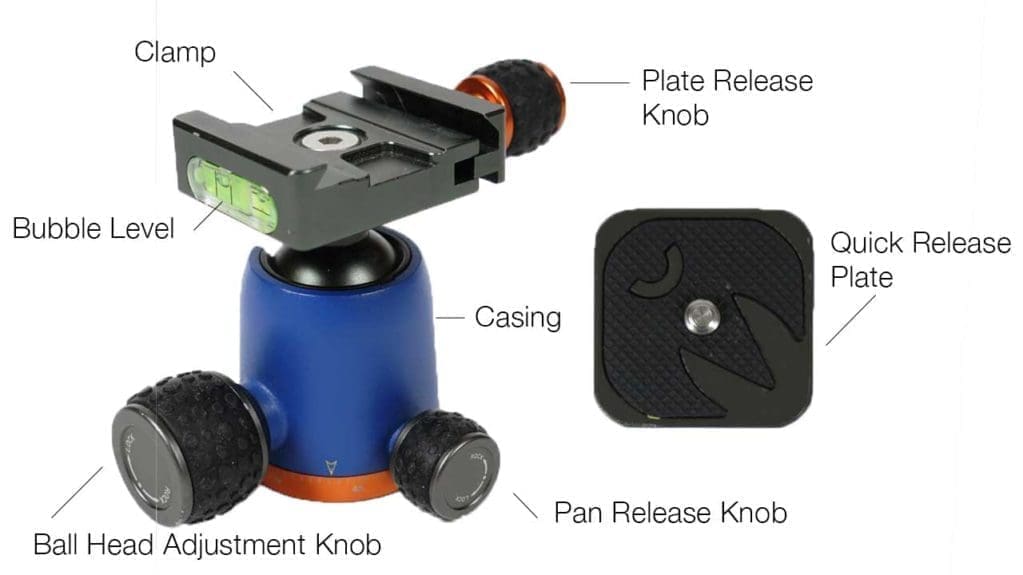
The small removable square is the base plate that bolts to the bottom of the camera and connects the camera to the base plate clamp on the tripod.
The clamp is operated by the plate release knob.
On the side of the clamp, you’ll see a bubble level, this acts as a guide to help you get the head level when setting up. Many tripods feature at least one bubble level with a second often being embedded into the canopy (we’ll come to the canopy in a bit).
Tripods are generally equipped with one of three types of head, ball, three-way or geared. The Billy features a ball style head which is a great all-purpose option.
Leaving the clamp and moving down to the ball which is held by the casing, on the side of the casing, you have two knobs — the ball head control knob that releases and locks the head and then the pan knob that releases the 360º pan movement.
At the base of the head, you have the pan base. Most Tripods enable you to remove the head so it can be swapped or replaced. Unscrewing the head from the Billy reveals a double ended bolt, this bolt can be flipped to reveal either a 3/8-inch or 1/4-inch thread.
If you remove the centre column and Column Lock (again we’ll cover the Column Lock in a bit) the head with Tri-Mount plate can then be screwed directly into the canopy to enable low-level shooting. The Tri-Mount plate is unique to 3 Legged Thing tripods.
The Tri-Mount plate can be attached to the canopy, with or without the head. You can choose to mount the camera directly on to the Tri-Mount plate using the ¼”-20 end of the main bolt double ended bolt.
The Centre Column
The centre column has evolved, it’s often no longer a simple pole that connects the head to the legs by the bit in the middle (aka canopy).
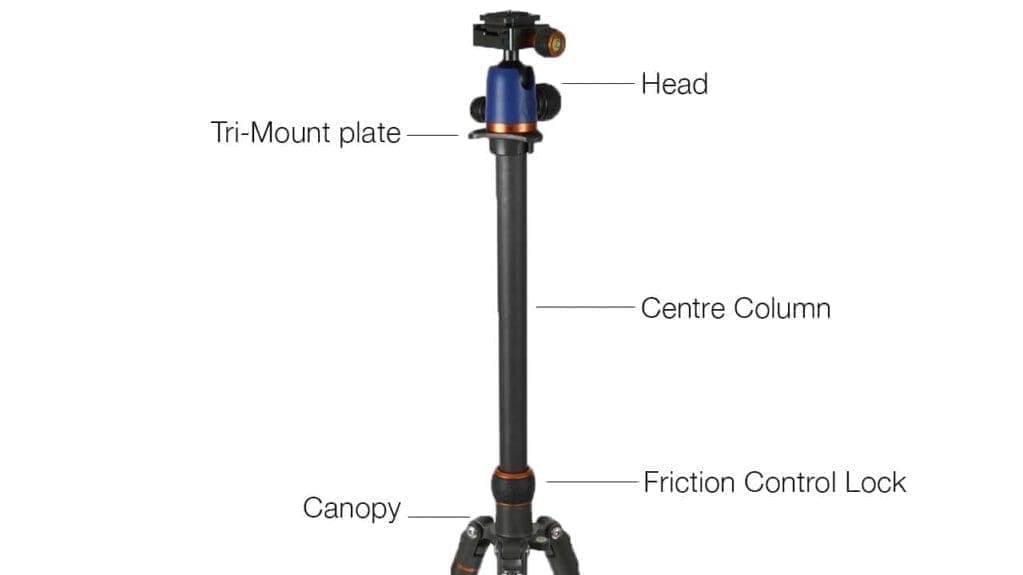
In many cases the centre column can be flipped, made into a monopod and all sorts of other uses, but what are it’s component parts? Let’s take a look.
Removing the head reveals that double ended bolt I mentioned earlier along with the mounting plate or Tri-Mount plate in the case of the 3 Legged Thing models.
The Tri-Mount plate enables straps, clips and all sorts to be attached, which is all very handy.
Down to the base of the centre column and you see the D-Ring. The D-Ring enables you to easily attach a bag to add more weight to the tripod for extra stability. You’ll find hooks and similar on other tripods and it’s a feature to look out for.
Unscrew the D-Ring from the lug, then release the twist lock around the centre column, known as the friction lock, and the centre column can be extracted.
With this tripod, the centre column can now be flipped upside down so it’s under the tripod for ultra-low-level shooting. Alternatively, it can be bolted to the removable leg to create a monopod.
Take a look back at the Tri-Mount plate and you’ll find this can be unscrewed and screwed directly into the canopy, as mentioned before, to enable another way means low-level shooting.
The middle bit
The main hub of the tripod is the canopy, sometimes known as the crown, shoulders or spider (rather incorrectly as it connects to three, not eight legs).
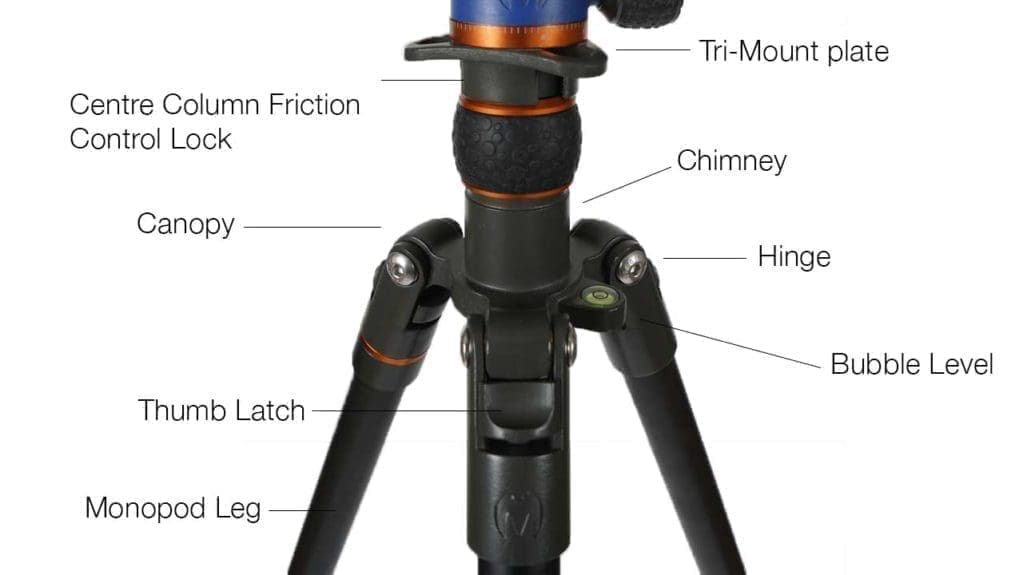
The job of the canopy is to bring the components together, with the centre column slotting through the centre and the legs attaching around the edge.
At the top of the canopy is the friction control lock, this holds and releases the central column. Here the friction control is of a twist lock style, but you’ll find bolts and all sorts doing a similar job.
On this tripod, I can unscrew the friction control from the canopy and then the Tri-Mount plate with the head can be attached for low-level shooting, as previously mentioned.
The canopy’s base features three hinges which connect to the legs. There are two significant parts of this small but essential part of the tripod design. The hinge and leg mechanism enable the leg to be attached and leg angles to be selected when the leg catch is released.
The legs
The main event. The legs can make or break a tripod and differ in weight and strength depending on the intended use of the tripod.
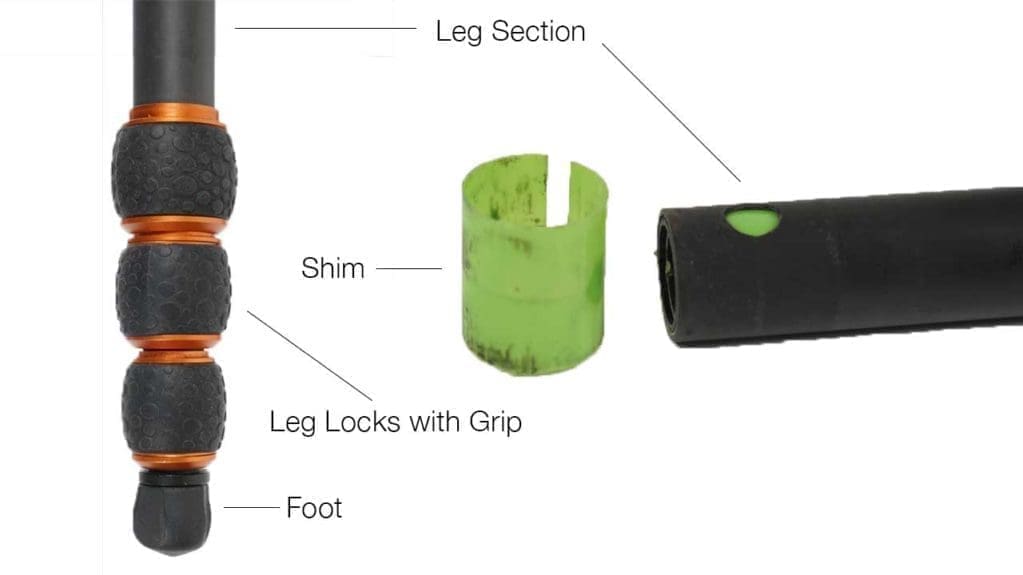
These are usually made from aluminium or carbon fibre. In the past steel and wood have also been popular options.
At the top of the leg is the hinge mechanism which bolts to the canopy. Built into this is the catch which enables the leg to be released and moved to the selected angle.
Moving down the legs and each section is held in place by a leg lock. Here we have twist locks, the main alternative design is lever locks which can be seen on the Punks Patti.
Twist locks are brilliant, but will inevitably need a good clean and service at some point in the life of the tripod. When they are removed for cleaning it will reveal a few additional component parts.
On the outer, there is the leg rubber. This is the grippy part of the twist grip. Then once the grip is fully unscrewed and the leg pulled apart, you’ll find the shim (Chicken lips in 3 Legged Thing’s case) is revealed.
The shim keeps the action of the legs smooth, true and stops each section from rotating inside the others as over time this movement would cause wear. It’s a good idea to strip down and clean your tripod once a season and it’s especially important that you check these for wear and tear.
Once the twist grip has been removed if you look inside, you’ll see the washer (Claw washer). This is what compresses on the leg to hold it in place.
A nice feature of some modern tripods is the removable leg. This untwists from the leg hinge and can then be bolted to the centre column or directly onto the Tri-Mount plate to create a monopod or boom.
On the 3 Legged Thing tripods, the removable leg is highlighted by a copper ring.
The bottom bit
Finally, we reach the base of the tripod, who thought there could be so much to learn about the humble support?
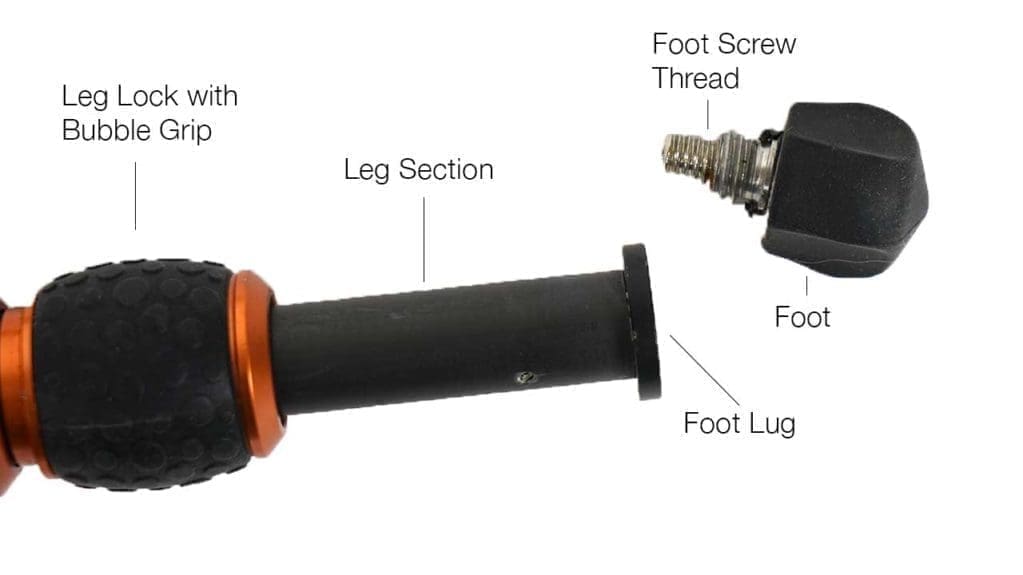
The feet. These are often removable, which is helpful as they’re the part of the product that will always have direct contact with the ground and are therefore likely to wear over time.
The standard feet are usually rubber, this is an excellent all-round material and will offer the best tripod to ground grip in most situations.
Having removable feet means that they can be swapped and changed as you need to suit the terrain.
If you’re shooting on a beach and find that the leg is sinking into the sand, then something with a little more surface area may be called for.
On 3 Legged Thing tripods, the feet can be unscrewed, and an alternative such as the wide footed Clawz can be attached.
Alternatively, if you need to strike a solid form on soft ground, then the spikes of the Stilettoz or the shorter Heelz may be called for.
Removable feet round off the tripod and bring us to the end of the tripod anatomy guide.
If you have any questions or comments, then please let us know.
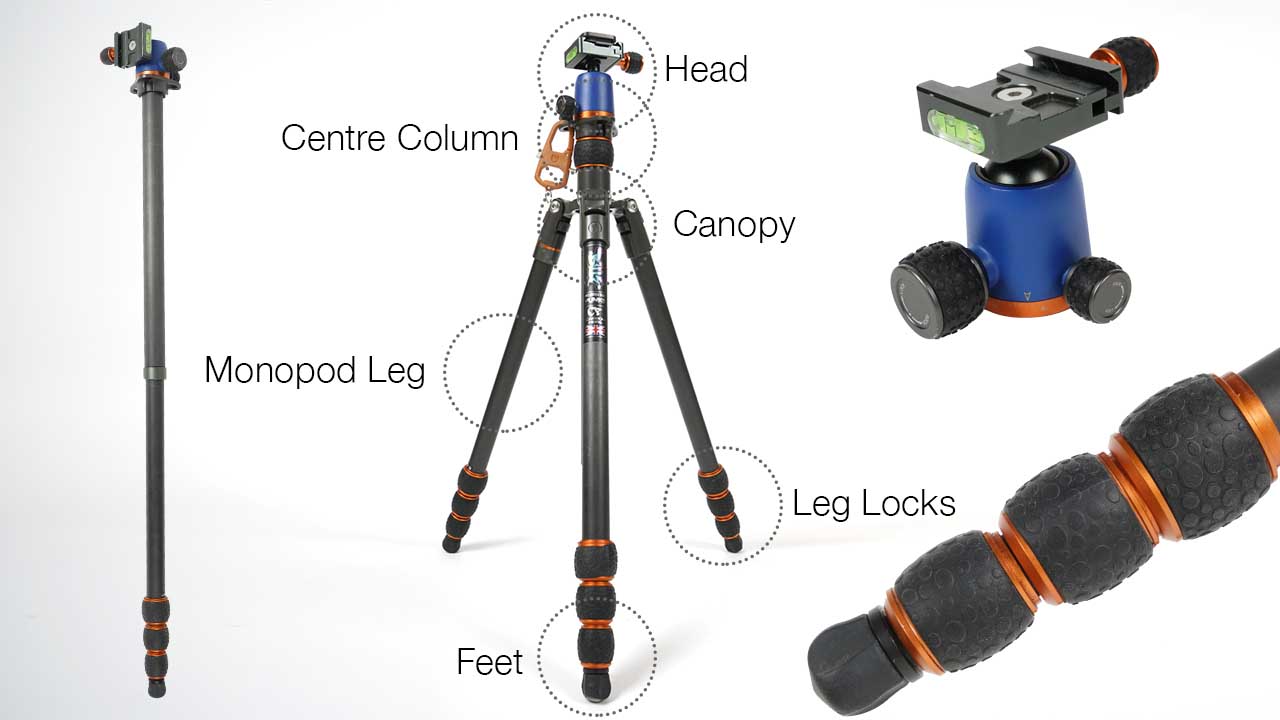



Thanks very informative. Now if we photographers could only find a source for these components so we could build our own tripods since really good tripods are hard to find for less than $700. Making the legs is easy but finding the crown/spider/top is much more difficult as is the cap for the top leg section. It has become almost impossible to find a 3 section tripod that has large top tubes, weights the correct amount and is very sturdy.
Where can I find shims for an Oben tripod?
I suggest you try contacting https://www.obensupports.com/